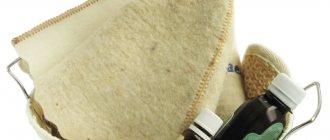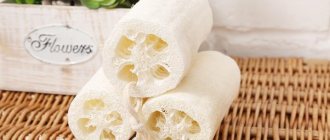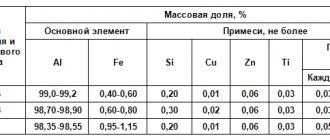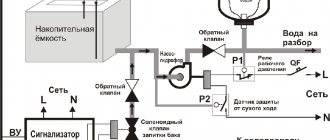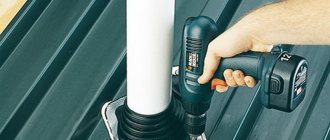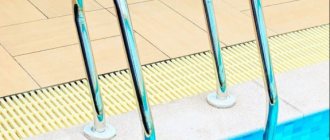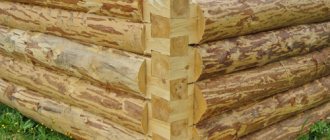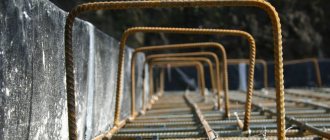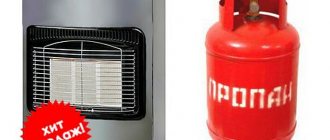Basic felting hat pattern for beginners
The pattern is not difficult. Even beginners can handle this, but it will be much better if you watch a special training video before doing so.
The first thing you need to do when cutting a hat for felting is to measure the circumference of your head.
Let's look at how to make a template step by step:
- First you need to make a calculation. For this we need the size of the head. We measure the circumference of the head and the length from the crown to the neck. We divide the resulting values in half and allocate a percentage for the shrinkage of the material.
- We determine the intersection point and withdraw the resulting amount from it. We get 4 points (half of the whole).
- We connect these points with a dotted line, maintaining a bell shape.
- Add the shrinkage percentage. 30% is enough. The percentage is calculated from the original data.
- We connect the resulting pattern with lines. When determining the percentage, pay attention to the type of wool. Its thickness directly affects the shrinkage of the material. The denser the material, the less it will settle.
This pattern is a help for beginners.
DIY sewn bath caps
For those who know how to use a sewing machine, it is probably easier to sew than to bother with felting and wool. Here everything is exactly the same, only the seams are made either externally or the fabrics are joined end-to-end using a zigzag or other similar stitch.
The peculiarity lies in the choice of material. It can be felt, thick wool, no less dense linen, but folded several times. The principle of choosing fabric is simple: the denser the better. Next, use the pattern to cut out the parts and grind them down. Whether seam allowances are needed or not depends on how you plan to connect the pieces. If it is butted, allowances are not needed, cut exactly according to the pattern. If the seam is external, its height is no more than 5 mm. Accordingly, set aside this distance.
Four-blade. Here are some cute bath hats you can get from such a simple pattern
Photos of the patterns are located below. You will adjust the sizes based on your measurements.
This is an eight-piece with a lapel
Hat - skullcap
Budennovka pattern
Step-by-step felting of a bathhouse cap: master class from professionals
For bath lovers, an original cap will be an excellent attribute in a hot sauna. Wet felting is great for wardrobe items. Consider a master class on making a bath cap.
To work you need:
- Material for pattern;
- Wool;
- Polyethylene;
- Nylon fabric;
- Warm soapy liquid;
- Sanding machine, if available;
- Gloves for work.
We make a pattern on paper. The hat will be in the shape of a bell. We focus on size 56. Based on this, the width is 44 cm and the height is 28 plus 6 cm to create a semicircle. Let's make another pattern on polyethylene.
We put the polyethylene under the paper and begin to lay out the wool. Let's choose the main shade and start working from the top of the head. Thin strands will make approximately 6 rows.
The next step is to wet press the pattern. Place a nylon cloth on top of the felt ball and moisten it with a soap solution. It will be convenient to use a spray bottle.
We begin to wipe the future hat, moving from the central part to the sides. When the wool lies evenly, you can begin to make circular movements, lifting the nylon fabric. These manipulations must be performed until the felt stops stretching.
We apply a film pattern to the product. It is necessary to press down the template well. Carefully tuck any protruding fibers behind the film.
Next you need to place the second ball. Now starting from the bottom and moving to the top. Next you need to carry out the same manipulations as with the first layer. Cover with a nylon cloth, moisten and smooth out a little. Then the hat blank must be turned over. Carefully tuck any protruding fibers behind the film.
Now you need to make a cross layer of wool. On the sides the villi can boldly protrude, while at the top and parallel to it a straight line should form.
The bath cap can be of any design, the main thing is to follow the instructions, then the result will not be long in coming
The thickness of the wool layer should be the same in both balls.
Then we again cover the cross layer with a cloth, spray it with soapy water, and rub it. Turn over and remove any protruding fibers.
On the other side the process is similar. Then repeat the cross layer on both sides. Total of 4 layers in total on each side.
The wool needs to be pressed. To do this, you can use a special machine or work manually. There is no need to process the edges.
Monitor the moisture content of the product. In case of high humidity, remove excess water with a towel.
Next you need to roll the hat onto a stick and roll it on a bamboo mat. The procedure will take 5 minutes, after which the product is straightened and the felting side is changed. You need to allocate 20 minutes for this. During surgery, smooth out any creases. After this, the cap must be turned out and the procedure repeated. The product resembles a cap.
It’s time to add a soap solution to well-felted wool. It is better to work with gloves. You need to crush the product thoroughly.
While felting, straighten the craft on both sides.
When the product begins to shrink, you need to put the hat in hot water and wrinkle it a little. Next, lower the product into cold water. Repeat this contrast again. This is an important measure so that the hat gets used to changes in temperature in the bathhouse. When finished, rinse the product in warm water and dry with a towel.
The still wet hat must be put on the workpiece and given the desired shape.
If desired, you can create a woolen decor. You can also make the lining on silk.
Taking into account hobbies and professions
There are many more interesting ideas for designing bath caps. Some are produced by various small factories, but there are also original works. Let's start with the factory ones. The well-known bell hats are no longer interesting. There's only something exclusive there, that's the inscription. But finding a bath hat that will hint (or shout) about another hobby of its owner besides bathing is already interesting. For example, there is a samurai set - a bamboo broom and a strange hat. Steaming with a bamboo broom is probably for the “advanced,” but a hat can bring a lot of fun.
A set for an oriental lover. An interesting bath cap and a bamboo broom - extreme, however
For football fans there are ball-shaped hats. For dandies who prefer jeans and wide-brimmed “a la cowboy” hats, there are also such options.
Knowing your friends’ hobbies, it’s easy to choose a bath cap
I found an interesting bathhouse hat in the shape of a knight's helmet, there is also one with pilot's glasses, a cap, a cap, a hat with bands. So there’s already room to roam around here.
These are no longer hats. These are bath hats
An interesting idea - felting a hat with ears
The felting technique can be used when creating a hat with earflaps. You can also create children's versions of the product with cat ears.
Let's consider an interesting option for hats with ears. For work we will need:
- Wool is the main material;
- Material for pattern;
- Soapy water;
- Polyethylene;
- Sanding machine (if available).
The system for felting a hat with ears is no different from a regular hat: we apply several layers of wool, thoroughly wetting and compacting the pattern on both sides
The usual pattern involves a circle in the shape of the head. For hats with ears, you need to cut out an ellipse. We take head circumference data, but stretch the circle. The correctness of the calculation can be easily checked using a thread. Use it to measure the circumference of your head and compare it with the drawn ellipse.
The most important part of the pattern is drawing the ears. We draw them in a circle, taking into account that the ear deviates from the center if you look at the head profile drawing.
At the end of intensive felting, we give the product a contrasting bath, after which we rinse the hat and allow it to dry on the workpiece. Malachai is ready to use.
Features and Benefits
Among nonwoven materials, a distinction should be made between felt and felt, although both materials are similar.
Felt can be either natural from the fluff of rabbits and goats, or from synthetic fibers. Compared to felt, felt is a more flexible, soft and lightweight material. Although these characteristics apply more to felt and factory-produced felt. Craftsmen who felt by hand create felt of varying densities and thicknesses, from translucent webs to fabric several centimeters thick.
An important feature of felt hats is the use of exclusively natural materials in their production, since only 100% sheep wool can be felted. In such a hat it is not hot indoors and not cold in the cold. This means you don’t need to take it off on public transport or in a store, which will allow you to preserve your hairstyle and the intended image as a whole. Felt is an excellent thermostat that does not allow moisture to pass through, but absorbs it like a sponge. The felted hat is not afraid of snow and is not blown away by the wind. At the same time, the hat is lightweight, you can roll it up and put it in your purse without fear of ruining it.
A felted hat is a bright and unusual accessory that will not let you go unnoticed. Therefore, when choosing a felt hat, you should carefully consider your overall look.
Felting a men's hat for everyday wear
Wool hats retain heat well and regulate humidity. For a fisherman husband, such a gift will be a real salvation on winter fishing.
In the appropriate store you need to buy wool of the desired color and density.
For felting a men's hat, it is better to choose practical dark or gray wool options
The set of tools remains the same. We will need:
- Wool;
- Polyethylene;
- Soapy liquid;
- Felting machine (if available);
- Pattern paper;
- Nylon fabric.
The sequence of work and technique is maintained. We measure the circumference of the head and make a pattern. Next, we place the felt in several balls and knead it thoroughly, spraying it with soapy water.
After repeating the manipulations on both sides, we begin felting. The process will take about an hour. After this, we wash the product and leave it to dry on the workpiece.
In Georgia, woolen hats are considered a traditional headdress for men. This wardrobe item can be found in every Georgian.
Felting a hat at home (photo of the process)
Similar articles
- Felting felt boots: for a doll, video master class from dry wool, at home, souvenir template, pattern for wet felting, for children for beginners
Felt boots can be not only shoes, but also an original decorative element. Today the situation has changed radically and anyone can work with wool... - Hydrangea from foamiran: how to make a master class, photos of flower templates, video, how you can replace the pattern and molds, with your own hands
Hydrangea from foamiran is one of the most popular flowers among florists. If a flower from foamiran falls, it will remain intact, will not wrinkle or break off,… - Do-it-yourself patchwork blanket: patchwork quilts, photos, master class for beginners, patterns from squares, how to sew a double-sided blanket, video instructions
Each patchwork product is unique: it is simply impossible to repeat it exactly. If you look at numerous photos or videos depicting patchwork…
What to wear with
Today, a felted hat is made so skillfully that it easily fits with any type of outerwear. For example, a felt hat with fur trim looks luxurious in combination with a fur coat or woolen coat. Original models with horns and ears are also suitable for a youth jacket or down jacket.
Felting a hat will give you the opportunity to reveal not only your creative abilities, but also bring things of unusual beauty to your wardrobe. Felting is an old craft that was widely used in creating wardrobe items. In the old days, not a single fair was held without sales or purchases of felted items. There are two felting techniques: dry and wet. For wardrobe items use wet, for bulky items - dry. Wet felting a hat involves compacting the material to form a single fiber.
